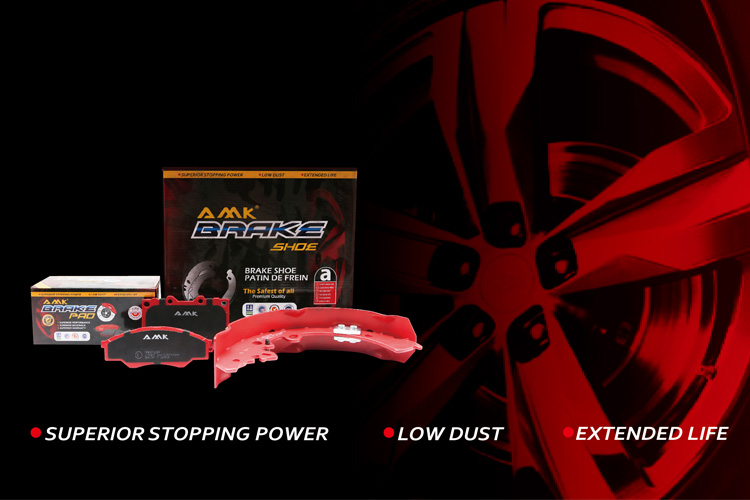

Method 1: look at the mileage:
ExploreBrake pad, as the most critical safety part in the automobile braking system, plays a decisive role in the braking effect. It can be said that it is the protector of people and cars.So, is there a potential safety hazard in your car's brake pads? Today, We will take you to pick it up. Generally speaking, it is necessary to consider replacing the brake pads when the vehicle travels to about 40000 to 50000 km. In real life, it is often the case that one kind of brake pad can be used for 50000 or 60000km in one vehicle, but it must be replaced when it is only used for 25000km in another vehicle. When the brake pads are seriously worn, the brake disc indicator light on the instrument panel will turn on to prompt the owner to replace the brake pads, which is the simplest and convenient judgment method. So, what other methods are there? Today, we will tell you about several other specific judgment methods with a "professional" attitude.
ExploreIn the rainy season, many car owners usually worry. Driving is easy to slip, cause blurred vision, reduce visibility, increase the risk factor of driving, and it is a potential "harm" to their car. We has sorted out some tips for driving and maintenance on rainy days for you. Driving in rainy and unexpected showers will meet more safety constraints than usual, such as visibility, tire braking capacity and so on. When driving in rainy days, pls drive safely.
ExploreThe process of braking is the process of two brake pads clamping the brake disc, generating friction between them and reducing speed. Therefore, the quality of brake pad and brake disc materials and the size of friction coefficient will directly affect the braking performance.
ExploreDrive safely in rainy days
In the rainy season, many car owners usually worry. Driving is easy to slip, cause blurred vision, reduce visibility, increase the risk factor of driving, and it is a potential "harm" to their car. We has sorted out some tips for driving and maintenance on rainy days for you.
Driving in rainy and unexpected showers will meet more safety constraints than usual, such as visibility, tire braking capacity and so on. When driving in rainy days, pls drive safely.
Inspection before departure
First check the wiper. It is best to try every gear of the wiper to see if it works normally. In addition, pay attention to whether the wiper is dry. If it is not clean, it must be replaced in time. Because driving in rainy days, if the wiper fails, the consequences will be very serious.
In addition, the tire that is worn to the limit is also a hidden danger of driving in rainy days, so pay attention to whether the tire has abnormal wear before driving.
How to remove the fog generated on the windshield during driving?
The most common way is to turn on the air conditioner. This is because the cold air blows on the glass, forming a "cold film" on the surface of the glass to prevent carbon dioxide from condensing on the glass and play a defogging effect. You can also go to the auto parts store to buy demister or anti fog towel. Spray the demister on the glass surface in the car and wipe it clean. While removing the glass dirt, it can also form a thin transparent protective film on the glass to prevent water vapor from condensing on the glass and forming a fog layer.
Can you claim for compensation from the insurance company after the engine is flooded?
The auto insurance does not include water related insurance. The auto water related insurance is an additional insurance and needs to be purchased separately. Water related insurance can only cover engine problems. Water ingress into transmission and other parts of the vehicle is not included in water related insurance. When purchasing insurance, the owner shall consult the protection scope and claim settlement rules of various insurance types.
What should you pay attention to when parking in rain?
First, stop in the rain and don't turn on the air conditioner. In rainy days, when parking at low speed, gasoline cannot be fully burned due to the influence of water vapor, air temperature and engine speed. When the car stops but the air conditioner continues to open, and the doors and windows are still closed, the air in the car can not convection. If the carbon monoxide discharged by the engine leaks into the car, it will gradually accumulate and increase its concentration, resulting in the bad consequences of poisoning and even death. Secondly, do not park in big trees, billboards, power poles, walls and other places where there are potential safety hazards in strong wind and rainstorm weather. Do not park in low-lying areas, such as tunnels, potholes, down ramps, under overpasses, etc., so as to avoid flooding.
How should the car be maintained after driving in rainy days?
1、 Dehumidification in the vehicle. When it rains, the cold air should be turned on, which can not only remove fog, but also dehumidify. Pay more attention when the rain stops. The accumulated moisture should be removed as soon as possible, otherwise it is prone to mildew and other conditions.
2、 Sterilization in the vehicle .After rain, due to temperature and other factors, it is easy to breed all kinds of bacteria, so it is particularly important to disinfect and sterilize the space in the car. Focus on cleaning all dead corners.
3、 Cure the chassis. The owner can conduct a "chassis sealing", which can isolate the chassis from the outside world, achieve the functions of anti-corrosion, rust prevention and sound insulation, and effectively prolong the service life of the vehicle body.
4、 Check the brake. Because the braking system has a very strong adsorption force, rainwater is very easy to enter the brake fluid, which will affect the braking effect and seriously cause braking failure. The way to deal with this situation is to go to a professional maintenance shop to check the braking system after the rain.
Deal with emergencies calmly
Do not brake hard in case of emergency
In case of unexpected events ahead during driving in rainy days, the vehicle speed shall be controlled by inching braking or sequential downshifting (commonly known as gear type). Do not brake vigorously or turn the direction sharply, which will cause the risk of side slip of the vehicle. In addition, due to the formation of water film between rain and tires, the braking performance of the vehicle is reduced and it is easy to produce sideslip. In order to prevent the vehicle from sideslip, it should not be too hasty when starting, stopping and turning. When using the brake, it is necessary to use the spot brake to avoid tire locking. If the side slip is caused by braking, the braking shall be cancelled immediately and the throttle shall be reduced. If the front wheel side slip, the direction shall be reversed. When reversing the direction, pay attention not to be too fast or too long, otherwise the vehicle may slide in the opposite direction; In case of rear wheel sideslip, correct the direction towards the side of sideslip, and do not turn it in the opposite direction.
Ingenious treatment of wheel mud pit
Driving in rainy days will also encounter the situation of wheels falling into mud pits. Once the car falls into the mud pit, first shift into reverse gear, then change the wheel travel direction, and finally shift into low gear to drive out of the mud pit with the impulse of the engine. If the car continues to slip and cannot move forward and backward, stop the oil blasting immediately, dig out the mud or try to support the wheels, pad some firewood, stones, bricks, wooden boards, branches or wrap ropes around the driving wheels in order to increase the grip of the wheels, prevent overturning and make the car go out of the mud pit smoothly.
Don’t be afraid of lightning and thunder
In case of lightning and thunder, some drivers are afraid of lightning hitting the car, so they choose to get out of the car to take shelter from the rain. In fact, this method is not necessary, because on the one hand, they may encounter theft and robbery; On the other hand, when lightning strikes the car, the current will be transmitted to the ground through the body surface, and people will not feel it inside the car, but the premise is that all the windows must be closed and the radio antenna must be retracted.

E-mail: amkautopartsco@gmail.com
Add: 776/28 THE CONNECT 35, PATTANAKARN SOI.38 PATTANAKARN ROAD,SUANLUANG, SUANLUANG,BKK.10250 THAILAND.Bangkok Thailand